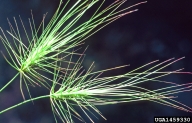
Courtesy and
Copyright © Steve Dewey
 Flower
Flower
Courtesy and
Copyright © Steve Dewey
 Plant
Plant
Courtesy and
Copyright © Steve DeweyWeedy plants of old world origin threaten natural areas throughout the United States. An invading plant colonizing a completely new area often lacks the insects, diseases and herbivores that kept it in check back in its native homeland. If the introduced plant grows and spreads vigorously, it can spell disaster for the native inhabitants of its new home. With no natural controls in place, it may outcompete native plants and greatly diminish biodiversity. Disturbed or degraded habitats are most susceptible to invasion by Eurasian weeds.
Utah hosts many invasive weeds causing problems throughout the state. One Eurasian grass threatening sagebrush habitat and rangeland is medusahead rye. Medusahead rye probably came to the United States as a seed contaminant in the 1880’s. The seed head is heavy, so on its own, cannot spread far. But the seeds do have a ticket for dispersal: tufted hairs which cling and readily attach to livestock and vehicles. Once on site, medusahead grows vigorously, crowding out other plants.
Medusahead tissue contains abundant silica which slows its decomposition. The accumulation of dead material forms a dense thatch that smothers other plants. This dry thatch layer can also fuel wildfires. In addition, the gritty silica makes medusahead unpalatable, so both domestic and wild grazing animals avoid eating it. Infested ranches can lose 3/4 of their grazing capacity.
Sage grouse are already in trouble due to habitat loss, and medusahead has invaded more than 10 million acres of the sage brush that sage grouse call home. Once invaded by medusahead, sagebrush habitat is very difficult to restore. The best hope is to prevent or at least hinder its spread through management using controlled burns, herbicides and careful grazing. Non-native, invasive plants are among the most serious threats to our natural world and the habitats and species we know and love.
This is Linda Kervin for Bridgerland Audubon Society.
Credits:
Images: Courtesy Steve Dewey & www.invasive.org
Center for Invasive Species and Ecosystem Health, University of Georgia
Theme: Courtesy & Copyright Don Anderson as performed by Leaping Lulu
Text & Voice: Linda Kervin, Bridgerland Audubon Society
Additional Reading:
Linda Kervin’s pieces on Wild About Utah
The United States National Arboretum. formerly https://www.usna.usda.gov/Gardens/invasives.html
National Invasive Species Information Center. https://www.invasivespeciesinfo.gov/plants/medusahead.shtml
Forest Service Employees for Environmental Ethics. https://www.fseee.org/component/content/article/1002329
Utah State University Cooperative Extension. https://extension.usu.edu/cache/files/uploads/Medusahead%202-10.pdf
